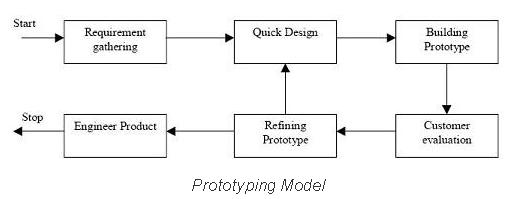The basic idea in Prototype model is that instead of freezing the requirements before a design or coding can proceed, a throwaway prototype is built to understand the requirements. This prototype is developed based on the currently known requirements. Prototype model is a software development model. By using this prototype, the client can get an “actual feel” of the system, since the interactions with prototype can enable the client to better understand the requirements of the desired system. Prototyping is an attractive idea for complicated and large systems for which there is no manual process or existing system to help determining the requirements.
 The prototype are usually not complete systems and many of the details are not built in the prototype. The goal is to provide a system with overall functionality.
The prototype are usually not complete systems and many of the details are not built in the prototype. The goal is to provide a system with overall functionality.
Diagram of Prototype model:

Advantages of Prototype model:
- Users are actively involved in the development
- Since in this methodology a working model of the system is provided, the users get a better understanding of the system being developed.
- Errors can be detected much earlier.
- Quicker user feedback is available leading to better solutions.
- Missing functionality can be identified easily
- Confusing or difficult functions can be identified
Requirements validation, Quick implementation of, incomplete, but
functional, application.
Disadvantages of Prototype model:
- Leads to implementing and then repairing way of building systems.
- Practically, this methodology may increase the complexity of the system as scope of the system may expand beyond original plans.
- Incomplete application may cause application not to be used as the
full system was designed
Incomplete or inadequate problem analysis.
When to use Prototype model:
- Prototype model should be used when the desired system needs to have a lot of interaction with the end users.
- Typically, online systems, web interfaces have a very high amount of interaction with end users, are best suited for Prototype model. It might take a while for a system to be built that allows ease of use and needs minimal training for the end user.
- Prototyping ensures that the end users constantly work with the system and provide a feedback which is incorporated in the prototype to result in a useable system. They are excellent for designing good human computer interface systems.
You might also be interested in :
What is Waterfall model?
What is Agile Model?
What is V-model?
What is Incremental model?
What is Spiral model?
What is RAD model?
Other popular articles:
- What is Iterative model- advantages, disadvantages and when to use it?
- What is RAD model- advantages, disadvantages and when to use it?
- What is Incremental model- advantages, disadvantages and when to use it?
- What is Compatibility testing in software testing?
- What is Waterfall model- Examples, advantages, disadvantages & when to use it?
Elton Kanyerere says
I have learnt a lot thank you for sharing, its so educative
Chandan Kumar says
Can these contents be used as a lecture parts by any teacher in online mode. Because it is mentioned that all contents are copyright of tryqa.com.
ISTQB Guide says
Yes, teachers can use them in lectures as long as they are giving credit to tryqa.com
mlondi says
Nice, which process model was used to develop Microsoft Excell ?
Daphine Namugabe says
kindly send me the reference of this article so that i can refer on my paper
Anaaba Sulemana Ussif says
please kindly send me the reference of this article so that i can refer on my paper
Muntari sada kurabau says
thanks so much
marley says
Thank you so very much. Was really helpful
melchor mantilla says
May i know the sources or references used in this article?
ISTQB Guide says
We don’t have a list of references but they are based on several books, ISTQB material, our experiences in software testing and other online resources.
saidi says
helpful information.
Tahir says
Which model we choose for critical system and facing different requirements changing from the customers.
ali says
what the author name i for reference in my project.
ISTQB Guide says
The authors name is S Kumar
takundamn says
thanks so much for this data, am learning a lot from you guys, keep it up 🙂
payman says
very nice
jacob evarist says
you guys your really working hard, proceed making us learn more
Tinotenda Mazikana says
it is really helpful
Student says
@istqb exam guide , could you pls explain the differences between prototype , incremental and iterative models?
Shital says
Really so good explanation !!
Sandra dogzky says
Thankyou so much… This is. So helpfull
Oscar says
thanks i love this website as it is really helpful
putti says
thanks for simple explantion
AJ says
Whos the creator or author of this particular prototype model?
UNISA KABBA says
hay i feel so good about what i learn thanks so much
UNISA KABBA says
hay i so good about what learn thanks
lorraine says
thanks… so helpful
lauren says
sorry spelt tonne wrong lol :[ :'( XD xooxrawr
lauren says
amazing- helped me so much, thanks a ton
obageto says
Thanks i like the way you xplain it. Simple to comprehend.